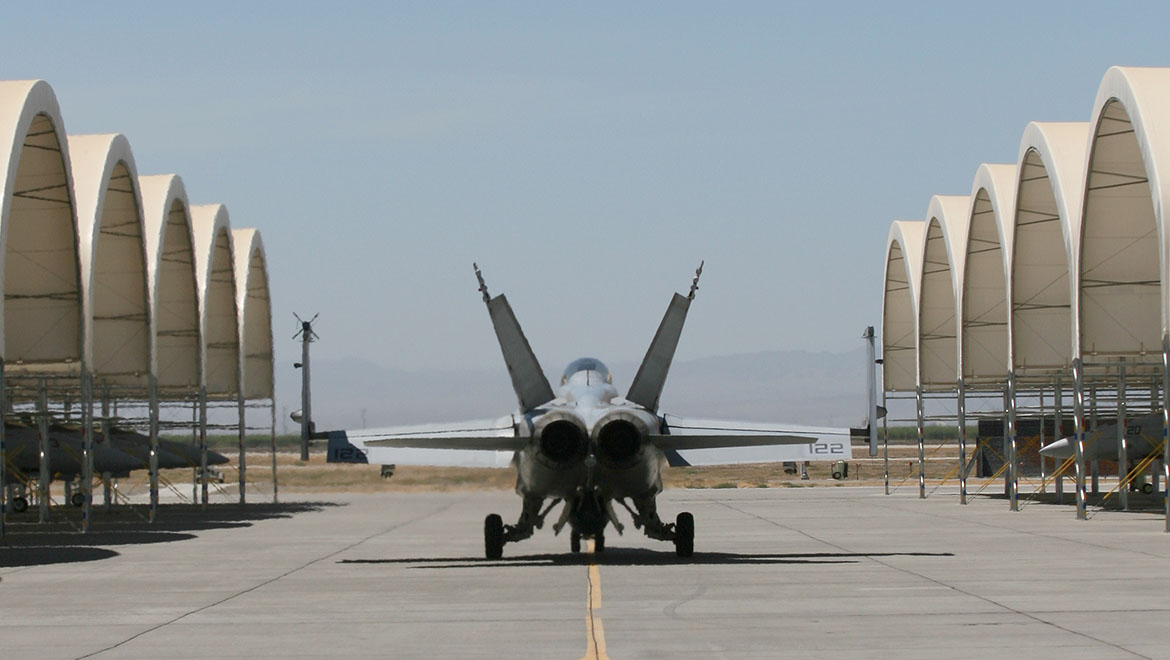
This week’s Throwback Thursday feature by Andrew McLaughlin comes from the October 2007 magazine edition of Australian Aviation, and looked at VFA-122, the US Navy squadron which trained the initial cadre of RAAF Super Hornet aircrews.
The US Navy’s main west coast base at Naval Air Station (NAS) Lemoore in California is home to up to 400 F/A-18C/D and E/F Hornets, including VFA-122, the USN unit that will be responsible for training the RAAF’s initial cadre of F/A‑18F Super Hornet pilots, air combat officers (ACOs) and engineers from mid 2009.
Lemoore lies on a vast 6475-hectare site in the rich farming area of California’s Central Valley near the city of Fresno, about 200km southeast of San Francisco. Large tracts of farmland inside the base’s boundary act as a buffer zone, but also provide revenue and fresh produce to the base from tenant farmers.
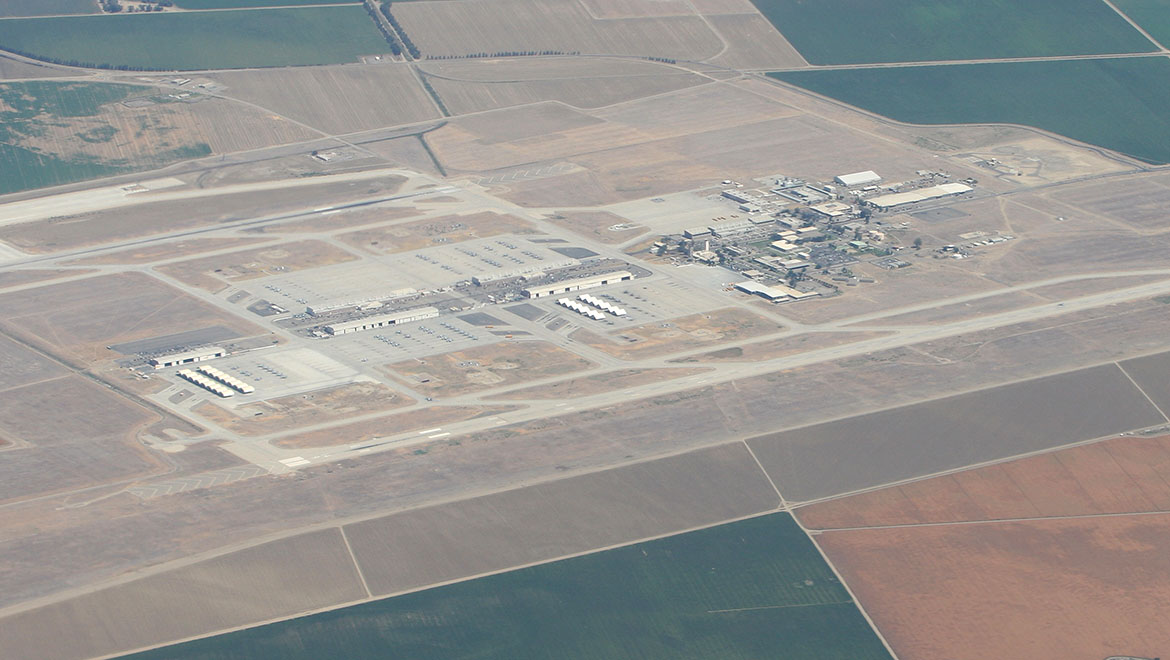
(Andrew McLaughlin)
There are 18 squadrons of F/A-18s based out of Lemoore; nine ‘legacy’ F/A‑18C/D squadrons, and nine F/A-18E/F Super Hornet units; comprising roughly half of the US Navy’s total frontline combat aircraft. Four of these squadrons are forward deployed to NAS Atsugi in Japan to support the USS Kitty Hawk carrier battle group (CBG), while other Lemoore based squadrons are often at sea with the USN’s five west coast carriers which are based in San Diego (USS Ronald Reagan, USS Nimitz), and at Bremerton near Seattle (USS Carl Vinson, USS John C Stennis, USS Abraham Lincoln).
While most of the units at Lemoore are active combat units, two of them, VFA‑125 and VFA-122, are Fleet Replacement Squadrons (FRSs). Formerly known as Replacement Air Groups (RAGs), the FRSs are tasked with converting pilots onto the C/D and E/F Hornets respectively and training them up to combat proficiency, in a role similar to that of the RAAF’s fast jet conversion units, 2OCU (Hornet) and 6SQN (F-111 – see Sept 07 AA).
VFA-122 has about 280 officers and 400 enlisted personnel on strength, between two and three times the size of an RAAF fast jet squadron, and was the first US Navy squadron to receive the Super Hornet in 1999.
“Twelve squadrons have transferred to the Super Hornet at Lemoore since 2000, all of them from the F-14, and all have been done with the Navy’s ongoing operational requirements having been met,” the recently appointed Commander Strike Fighter Wing Pacific, or ‘Commodore’, Captain Hal ‘Doc’ Murdock said.
“We’ve got a lot of experience doing this, and it’s certainly a very robust capability we have here, to not only be able to train the aircrews but also the maintainers.”
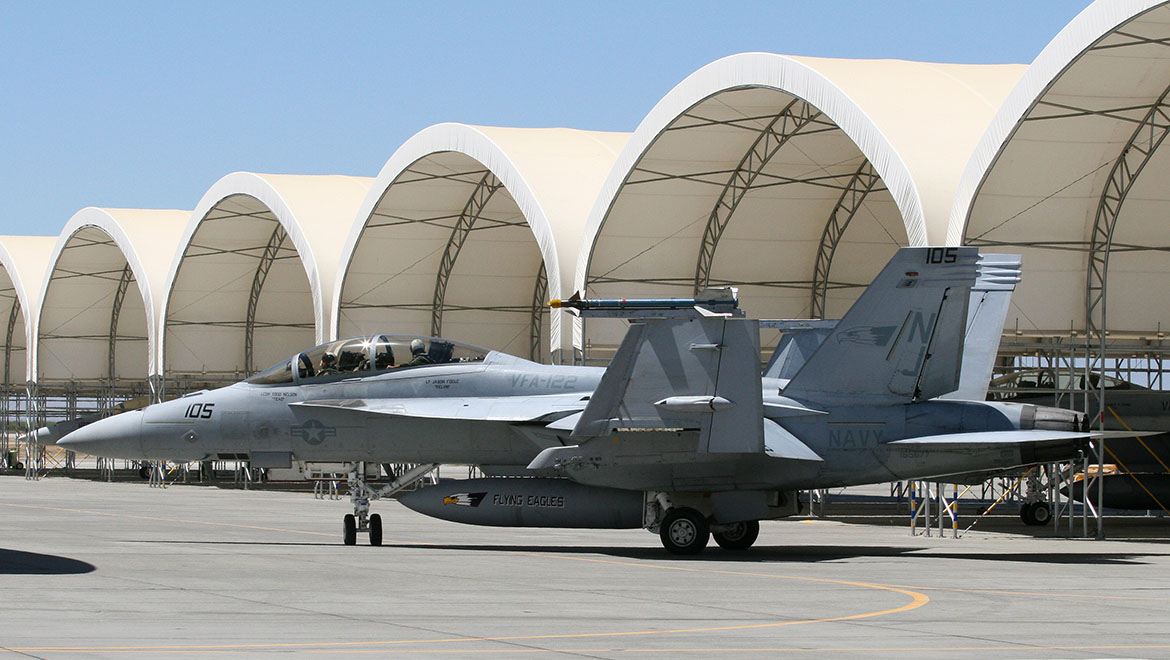
Certainly, the two FRSs at Lemoore will be well placed to advise the RAAF on the best way to move forward in transitioning crews and maintainers to the Super Hornet. The USN retired the last of its F-14s last year, an aircraft similar in systems complexity and technical idiosyncrasies to the F-111, in favour of the F/A-18F. And of course, it already operates hundreds of F/A-18C/Ds, many units of which will also be moving across to the Super Hornet in the next few years as some of the older ‘classic’ jets are withdrawn from service.
“The good thing is, the US Navy and the Aussies talk the same lingo when it comes to the legacy airplanes,” Commander Art ‘Kato’ delaCruz, VFA-122’s executive officer (XO) said. delaCruz is a former F-14 rear-seat radar intercept officer (RIO), and came to the Super Hornet after several combat cruises in the F-14. He will soon move across to an operational squadron and will be deploying on the first Block 2 combat ‘cruise’ early next year.
“I can tell you it’s a quantum leap – there really is no comparison!” he said of the jump from the F-14 to the Super Hornet.
“The amount of aircraft we have at the squadron fluctuates depending on our required levels of production,” delaCruz explained. “We usually have between 12 and 20 aircraft permanently assigned to our squadron, to which are added those belonging to the squadron that is being transitioned, so we can have up to 40 aircraft on the line sometimes.”
The staff at VFA-122 echoed the Boeing marketing line that it only takes “five rides” to transition from the F/A-18C/D models to the E/F Supers, although they emphasised that this only gives the crew a ‘Cat 1’ or basic handling proficiency of the aircraft.
“While it’s not the same aircraft, a lot of it is the same aircraft,” CDR delaCruz said.
“It takes about 75 hours in total to achieve a ‘Cat 3’ rating, which sees the crew declared tactically proficient to operate the airplane in combat. The new jets are pretty much delivered here to us straight from the Boeing factory in St Louis, and then the transitioning squadron arrives and we convert them to the aircraft.
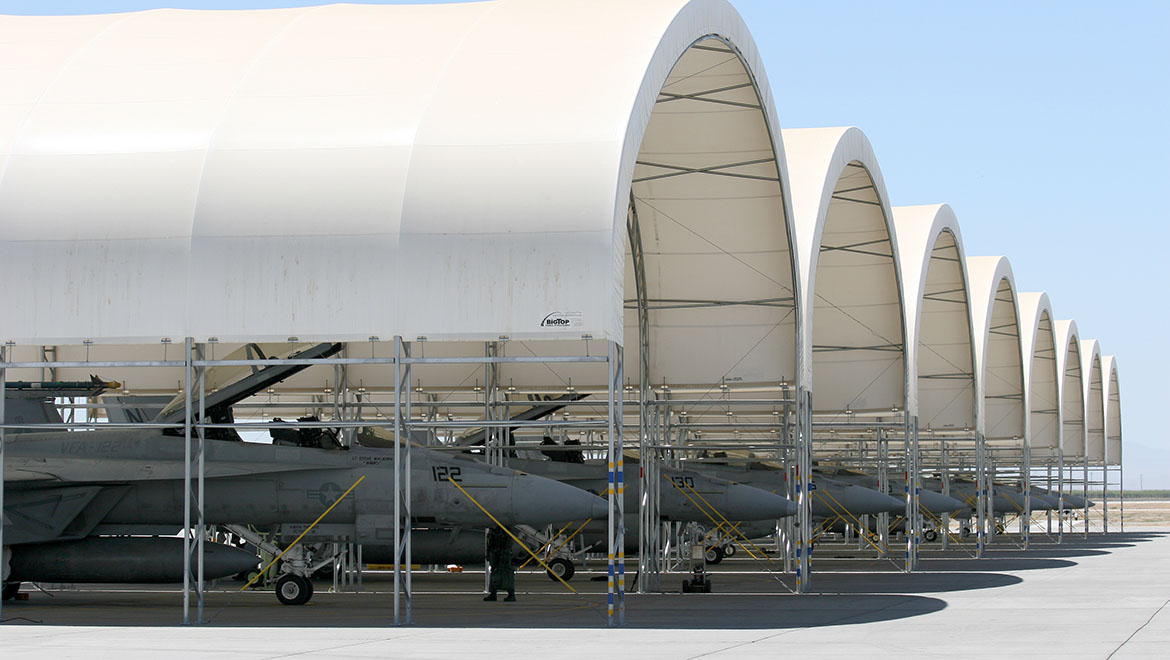
“Unfortunately when it’s all over they take all their nice shiny new airplanes with them.”
Lemoore also has some of the best aircraft systems trainers and facilities imaginable for aircraft maintainers. The fidelity of the full scale undercarriage, control surface, avionics bays, cockpit, weapons loading, and engine bay trainers is amazing, with students given practical, computer-based, and theoretical training on all the aircraft’s major sub-systems.
Despite still being a relatively immature capability, the Super Hornet is already showing some amazing in-service reliability results.
“As important as the combat role of the aircraft is, the maintenance aspect is equally important,” CAPT Murdock said.
“We’re currently seeing about 12 maintenance man hours per flight hour (MMH/FH) for the Super Hornet, compared to about 16 for a C/D, and more than 150 for the F-14 before it was retired. I would expect this to come down as the Block 2 enters service in numbers, as we haven’t had to pull an AESA radar out of an airplane here at Lemoore yet. From an operational perspective, the reliability and availability rates of this airplane means we are no longer launching spares or reserves.”
MORE THAN A BRIDGING BUY?
The ADF has labelled the Air 5349 F/A-18F buy as a Bridging Air Combat Capability (BACC), one that will buy the RAAF time between the retirement of the F-111 in 2010 and the introduction of the F-35, which is under severe budgetary and schedule pressure, from 2015.
It is no secret that the JSF Program Office (JPO), and through it the USAF and Lockheed Martin, have actively encouraged partner nations such as Australia to take early low-rate initial production (LRIP) F-35s, ostensibly so they can reap the benefits of introducing a fifth-generation capability early as well as to maximise any local industrial participation benefits. But perhaps more realistically it will help to push US deliveries further to the right of the production run and thus, by design, down the price curve. Whilst there’s nothing sinister in marketing the F-35 in such a way, the manufacturer and program office no doubt hope that in looking after their largest customer in such a way, it will be rewarded with additional orders from what will be cheaper full-rate production runs.
However, such a move has the potential to backfire on the JPO, in that partner nations may become disenfranchised with the program due to its spiralling costs and schedule slippages, and may instead order a bridging aircraft to buy them time like Australia has done, or perhaps even withdraw from the program altogether as has been threatened by Norway in the past.
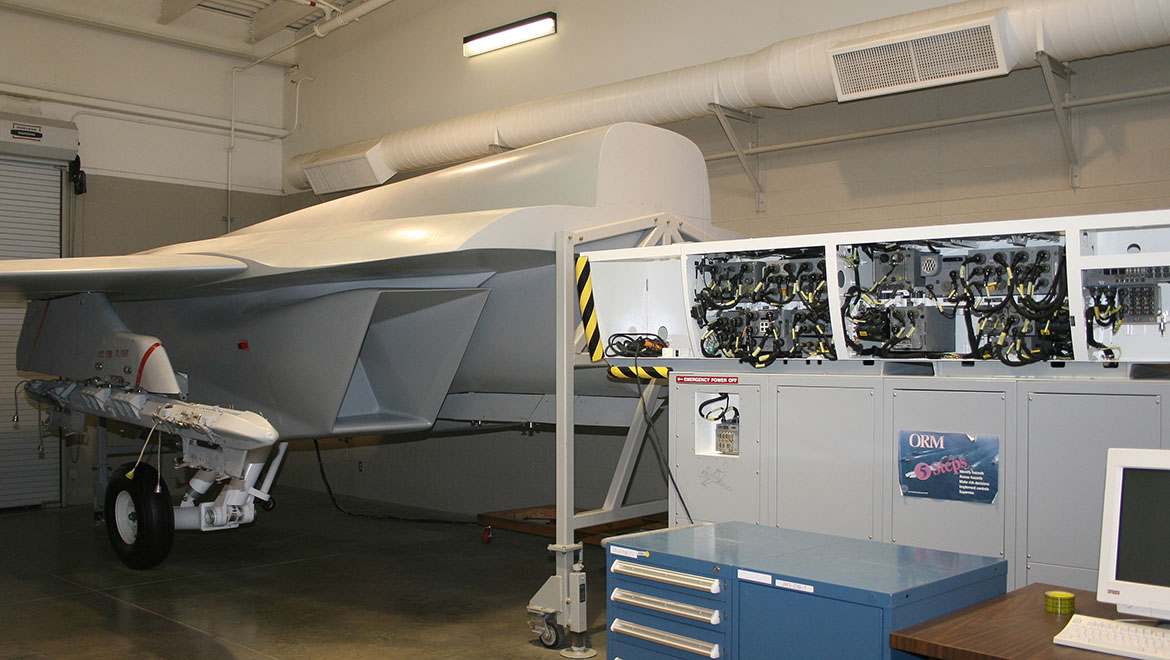
(Andrew McLaughlin)
Although it would never publicly admit as much, there’s little doubt Boeing and the USN have options in place in case there are further delays to the F-35 program. If this were to occur and be followed shortly after by a smooth Super Hornet service entry, it may ultimately see additional F/A-18Fs ordered by Australia, thus upgrading this ‘bridging’ capability into either one level of a two-tiered air combat force in conjunction with, or perhaps even as the ultimate Next Air Combat Capability (NACC) in place of, the F-35.
Indeed, whether by accident on the Minister’s part or by clever design by some elements within the RAAF, it is looking clearer that the capabilities the Super Hornets will bring to the table will do far more than just fill a five to seven year gap in airframe numbers on the ramp.
Australia’s F/A-18F Block 2s will be from the latest Lot 32 production build which is already in long-lead procurement. The first RAAF aircraft, A44-201, is due to be rolled out in July 2009, with US Navy Test and Evaluation (T&E) commencing soon after, and RAAF T&E following that November. For the first time, the ADF will have a platform with built-in low-observable features and fifth-generation avionics and sensors. Although the aerodynamic limitations of the Super Hornet’s airframe and its comparatively modest performance compared to the F-15, F-22 and Su-30 have been well documented by industry observers, commentators, and some former uniformed personnel, the aircraft’s operators have been encouraged by the performance of the Super Hornet as a whole system, particularly in its latest Block 2 form.
Raytheon’s AN/APG-79 active electronically scanned array (AESA) radar is reportedly the most advanced and robust fighter radar in service anywhere. It can simultaneously track multiple airborne and ground-based targets, operate in a synthetic aperture radar (SAR) ground mapping mode, and provide electronic protection to its host aircraft. Its imagery can be integrated with that of other aircraft sensors such as the ATFLIR targeting pod and ALR-67(v)3 radar warning receiver (RWR) to provide a ‘fused’ image of the battlespace.
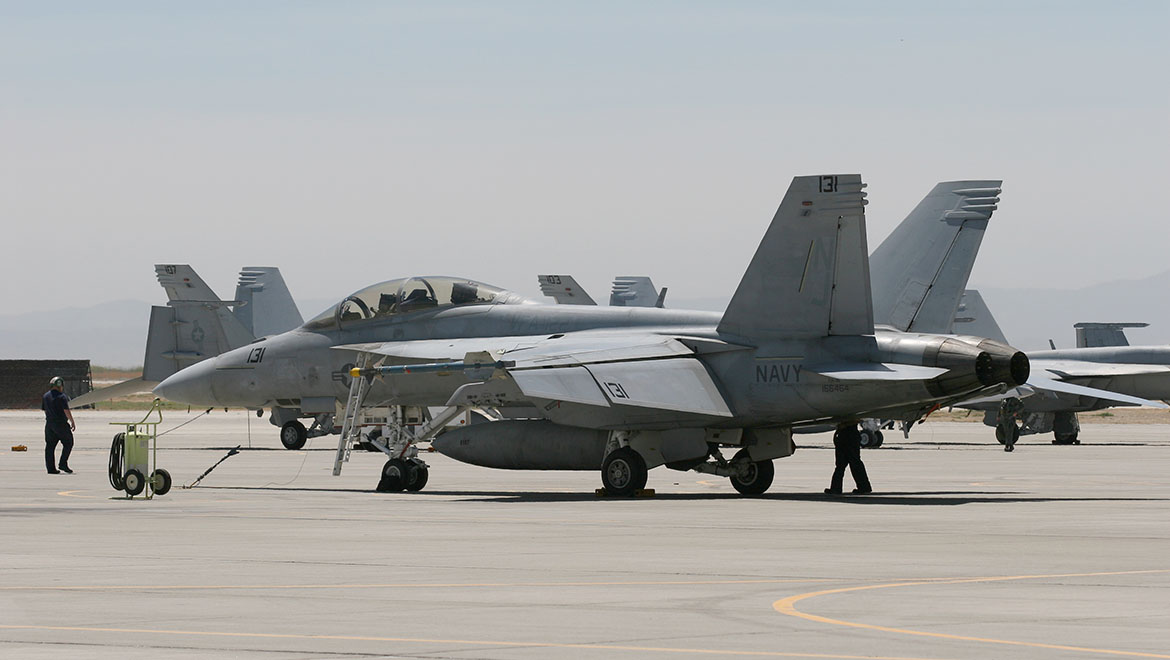
AESA radars have also demonstrated the ability to ‘stare’ or be focused at ground-based or airborne electronic systems such as surface-to-air missile (SAM) radars, and either damage or destroy them through a concentrated burst of RF energy, or be used to amplify an integrated electronic warfare system’s jamming capability. This is a capability which is expected to mature as the dedicated electronic attack EA-18G Growler enters operational test and evaluation in the next couple of years, and is planned to flow down to the AESA-equipped Block 2 Super Hornets.
Through its Link-16 MIDS datalink, a Block 2’s AESA radar picture can be transmitted to non-AESA equipped aircraft such as the RAAF’s F/A-18A/Bs in a combined strike or offensive counter air (OCA) scenario, or to local ground forces in a force protection scenario, or to a standoff AP-3C, BAMS UAV or Wedgetail AEW&C for enhancement of the battle-space picture, or even via ‘smart tanker’ or UAV relay to a ground station for near-instant analysis or command chain escalation.
Indeed, the upgrades provided to the RAAF’s F/A-18A/Bs through Phases 2.2 and 2.3 of the Air 5376 Hornet Upgrade program (HUG), such as their own MIDS terminals, Joint Helmet Mounted Cueing Systems (JHMCS), ALR-67(V)3, and enhanced cockpit displays will, when receiving data-linked sensor imagery, provide a fidelity of situational awareness close to that of the transmitting F-model’s crew. Without too much imagination, it is easy to see that such a ‘shared sensor’ scenario has the potential to provide much enhanced flexibility and numerous configuration options when planning strike packages.

“When you guys bought the Super Hornets, you weren’t just buying 24 new jets; you’re also improving every combat aircraft in your air force,” CDR delaCruz said.
“I mean, sure, the Su-30 is a remarkable aircraft aerodynamically, but we believe it’s the electronics that will really make the difference at the end of the day.”
“Compared to the ‘legacy’ C/D which is our baseline, we estimate the E/F is two and a half times more survivable against low threats (eg SAMs), and as much as five times more survivable against high threats (eg fighters),” CDR delaCruz said.
Without being specific, he added that “there are even a lot of areas where this aircraft is going to be even more survivable than some of the newer airplanes coming through.”
Certainly, a tour of Boeing’s Super Hornet factory in St Louis revealed more about the aircraft’s low observability features. Apart from the extremely close manufacturing tolerances which reduces radar reflecting panel gaps, the Super has details designed in such as radar-wave absorbing ‘saw tooth’ edges on its undercarriage and engine bay doors; faceted edges around externally mounted flight control sensors and heat exchangers; flush mounted antennae on the fuselage, leading edge extension (LEX) and wing; detailed faceting and shrouding of most control surface hinges and joints; a scattering “device” mounted deep inside each engine intake which shrouds the highly reflective compressor face of each engine; and the liberal use of radar absorbent coatings and composite materials in key areas.
TWO CREW
Another element that adds to the survivability of the two-seat F/A-18F is having two crew on board.
SQNLDR John ‘Johnny H’ Haly, an RAAF Hornet pilot currently on a two-year exchange posting with VFA‑122, has been impressed with the Super Hornet, particularly in its two-crew F-model form.
“To be honest, I was a dyed-in-the-wool single seat guy and was sceptical of how the two-crew setup would work,” he said.
“But now that I’ve has some time in the F model and particularly in the Block 2, I’m a real fan of the two-crew set up and will probably never go back.”
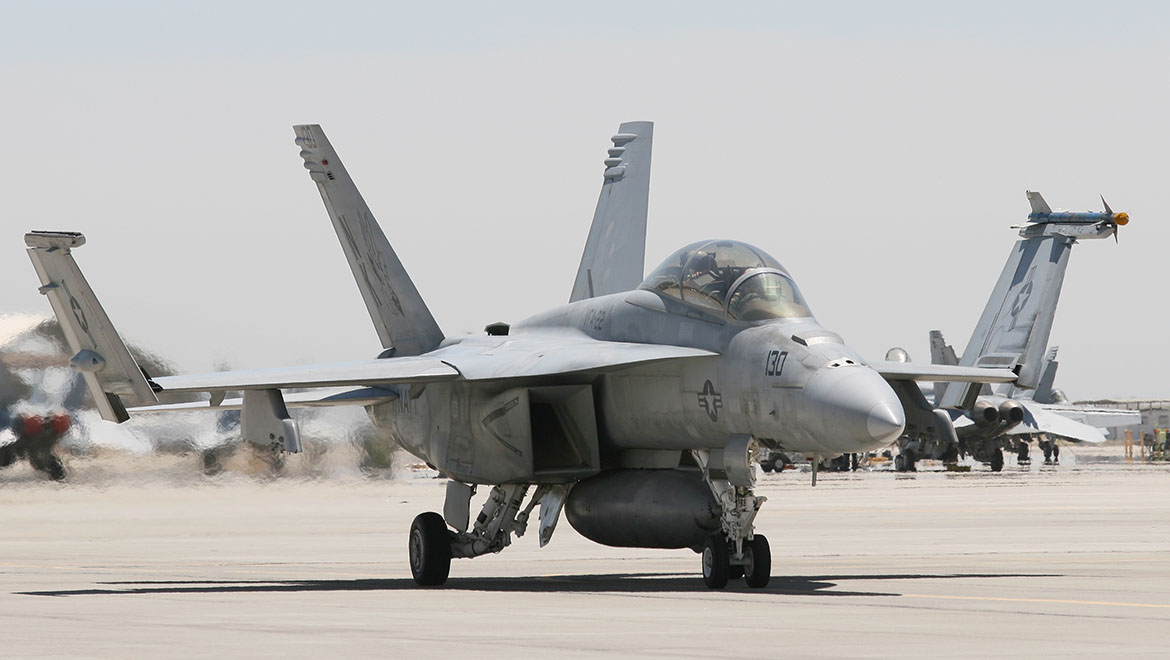
SQNLDR Haly is due to start his aircraft carrier landing qualifications (CQs) later this year as part of his exchange, and will likely have his US posting extended after his exchange replacement arrives next year.
“I’ve been here just over a year now and I may be here another three,” he said.
“It looks like I’ll be staying on here after the end of my exchange late next year to help set up the RAAF’s transition team, and will hopefully come back in the first jets in 2010.”
WEAPONS
While a weapons package for the F/A-18Fs is yet to be formally announced, Defence sources have stated that, in order to reduce risk on the project, the weapons acquired will be common to those used by the US Navy on their Super Hornets rather than attempt to integrate unique weapons and sensors currently in or planned for RAAF service.
This means that, while Mk-80 ‘dumb bombs, the GBU series of laser-guided and JDAM GPS-guided bombs, the Block II Harpoon anti-ship missile, and the AIM‑120C AMRAAM air-to-air missile will be common to both types of Hornet, the ASRAAM air-to-air missile, the forthcoming JASSM standoff strike missile, and the new Litening AT targeting pods from the F/A-18A/Bs are unlikely to find their way onto the Super fleet.
Instead, the RAAF’s Super Hornets will likely be delivered with a cache of AGM-154C JSOW stand-off GPS-guided glide weapons, the latest all-aspect AIM-9X version of the venerable Sidewinder air-to-air missile family, and the Raytheon ATFLIR targeting pod. Possible additions to this list could be the AGM-84K SLAM-ER land attack and anti-ship missile, current and future developments of the 120kg Small Diameter Bomb (SDB I & II), the datalinked Harpoon Block III, and perhaps a small number of centreline Shared Reconnaissance Pods (SHARP) to replace the capability lost with the retirement of the four RF‑111Cs.
The aircraft’s ALR-67(v)3 radar warning receiver and the JHMCS helmets will be common to those currently being integrated onto the RAAF’s F/A-18A/Bs under Phases 2.2 and 2.3 of the HUG program, and further enhancements to the Super Hornet’s weapon system are expected as future spiral upgrades are developed.
BUDDY TANKING
The Super Hornet also has the ability to refuel other aircraft in flight from a centreline ‘buddy’ tank and hose, and up to five external auxiliary fuel tanks.
While some weight has been placed on this capability the RAAF appears keen to downplay it despite having ordered an undisclosed number of buddy stores for the F/A-18Fs.

“I don’t want to put too much emphasis on the buddy refuelling aspect, as it’s not why we bought the jet,” SQNLDR Haly said.
“It’s like buying a top of the range four-wheel drive that happens to come with satellite navigation – it’s not why you bought the car, but it’s a nice feature to have and you’ll probably use it when you can.”
IN SERVICE SUPPORT
Air 5349 BACC program head GPCAPT David Langlois told delegates at August’s Defence+Industry conference in Adelaide that all maintenance beyond operational ‘line’ maintenance for the F/A-18Fs will be carried out by contractor support, and that he anticipates the RAAF will “plug into the US Navy’s support system where feasible.”
The F/A-18 Integrated Readiness Support Teaming (FIRST) partnership is a US Navy and Boeing partnership which is geared towards supporting the Hornets through a Performance Based Logistics (PBL) agreement, and it is likely the RAAF’s Super Hornet squadrons will slot into this arrangement and be supported in much the same way as USN forward based units such as those in Japan or at sea on a carrier.
The PBL arrangement will see most parts couriered to Amberley within an agreed timeframe as they are required by the units there, meaning few spare parts will need to be warehoused in Australia, technical and engineering design upgrades can be more rapidly incorporated, and parts use can be better forecasted. The contract in its current USN form allows for surge, contingency and crisis management support if required.
Talk of making Amberley a regional support base for visiting or regionally based USN Super Hornets, as well as those of possible future customers such as India, Malaysia and Japan, is in its preliminary stages, but there would be a number of political and technical release issues to be overcome if this plan were to be realised.

CONCLUSION
Recent anecdotal reports indicate the USN’s first AESA-equipped Block 2 squadron performed extremely well during exercises with USAF F-15Cs and F-16Cs in Florida. And while much has been made of the Super Hornet being designed as a ‘jack of all trades but master of none’, USN crews say that they feel having a true multirole aircraft underneath them gives them even more of an advantage.
“As an aviator, I don’t view the E/F’s non-specialised multirole capability as a liability; I see it as an asset,” CDR delaCruz said.
“That way, we can handle any threat thrown up at us, whether it be a low or a high threat, with a high degree of confidence.”
Perhaps SQNLDR Haly put it most succinctly when he said, “I can’t wait to get more of our guys into the jet so they can see what it can do for themselves. They’re going to love it!”
This article originally appeared in the October 2007 magazine edition of Australian Aviation. To read more stories like this, subscribe here.
















PAUL
says:Interesting article